Write / Edit a scientific paper is a long-term job. Whether for a young doctoral student or an experienced researcher, writing a scientific paper requires rigor. A scientific paper is often constructed according to a recurring pattern of which here are the secrets.

Page contents
ToggleWrite a scientific paper
An article begins with the title, abstract and keywords.
The text of the article follows the IMRAD format (IMRED in French), which meets the questions below :
- Introduction : What did you do/what did others do? Why did you do it?
- Methods : How did you do ?
- Results : what did you find?
- And
- Discussion: What does all this mean?
The main text is followed by the conclusion, acknowledgments, references and supporting documents. Writing a paper is not done in the same order as the plan. Writing is like a puzzle, each researcher has their own preferences for solving it.
A scientific paper is constructed according to the following plan:
- Title
- Authors and Affiliations
- Abstract
- Keywords
- Introduction
- Background
- Related Works
- Problem definition
- Materials and Methods
- Methodology
- Case Study
- Experiment
- Results
- Discussion
- Conclusions
- References
Sections in bold are almost always present while others may not appear in a scientific paper.

Title and header
The title must:
- Identify the topic of the paper
- Reduce scope of work
- Don't be too wide or too narrow (stay eye-catching)
The title is essential because it informs readers of the issue being discussed and the benefits they will gain from the article.

You can include a subtitle after a separator such as a colon.
Examples:
- MEgo2Vec: Embedding Matched Ego Networks for User Alignment Across Social Networks
- SSDMV: Semi-Supervised Deep Social Spammer Detection by Multi-view Data Fusion
- Formal vs. Case-Study-Based Approaches for the Identification of Cultural Influences in Requirements Engineering
- Big data analytics in supply chain management: A state-of-the-art literature review
- Systematic Literature Reviews in Software Engineering: Preliminary Results from Interviews with Researchers
For the header, its writing depends on the format of the article or newspaper. You must refer to the LaTeX template to know the rules.
Abstract (see the dedicated course for more details)
Write the summary after the content of the article!
The abstract has a word limit (usually between 100 and 250 words). It is a single paragraph without citations or abbreviations. He is content with himself (no need to read the introduction or another article to understand).
The summary must indicate:
- What is the goal/problem? (in yellow)
- Why is this important (social/industrial/scientific, etc.)? (in blue)
- How do you deal with the problem? (in green)
- Your main results
How will this contribute/benefit? (in red)
Keep in mind that the abstract is a kind of summary of the article, a kind of preface.

Keywords
Follow the template instructions or conference/journal listings.
Keywords are used for indexing and database searching, so choose them carefully. Use only one keyword or scientific field, be broad and narrow (Social Network, Tourism, Clustering, Distance measurement, Profiling).
Your article is high on the list of any keyword search that potential readers perform in databases.
Introduction (see the dedicated course for more details)
The introduction provides:
- What is the article about and why should the reader care?
- The context of the research (topic, motivation, scope)
- An overview of the current state of the art
A good introduction should answer the following questions:
- What is the problem to be solved?
- Are there any existing solutions?
- What is the best ?
- What is its main limitation?
- What do you hope to achieve?
The introduction provides the “what?” " so what? ". Be clear and remain objective.
Follow the following structure (each point can be a few paragraphs).
- Define the problem
- Motivation for the article (context) – first two points can be reversed –
- How will your problem answer contribute to context?
- A little context to understand the issues
- Brief link to related work (to better identify the gap in the next point)
- An account of what has not been adequately addressed by previous researchers in this context (what is the gap?)
- How will the answer to your problem contribute to the area of study?
- The solution in brief and what is new and interesting in the research (list of contributions)
- Some technical details of the proposed solution
- Paper preview
TL;DR: definition of the concept -> description of the context -> some justifications -> the diagram
DON’T: provide too much/unnecessary information
Literature review (see the dedicated course for more details)
First, write a paragraph with the most important related works (survey, books) regarding your research area/context.
Organize the paragraphs using your mindmap literature review ! Use \subsection* or \paragraph with a subheading in a different font/shape to make it clear!
Discuss related work in a specific area (a node/leaf of your mind map) with reference. Avoid plagiarism. Discuss the related word, how it works in your context, and the gap in your context.
At the end, summarize the shortcomings and explain how you avoid them/find a solution.
Materials & Methods (see dedicated course for more details)
When writing a laboratory report, it is often a good idea to start by writing the Materials and Methods section.
This section is generally very simple, and writing it first helps many people establish the thought process and understanding of the work that will allow the rest of the report to flow more smoothly.
This section gives a detailed account of the procedure that was followed to carry out the experiment(s) discussed in the report.
Such a narrative is very important, not only for the reader to have a clear understanding of the experiment, but a well-written Materials and Methods section also serves as a set of instructions for anyone wishing to replicate the study in the future.
Given the importance of “reproducible results” in science, it is quite obvious why this second application is so vital.
Example :
The materials present the data, its context and its particularities
Methods presents a detailed flowchart of the methodology research with paragraphs briefly describing the overall process.
Methodology (see the dedicated course for more details)
The goal is to describe how your study was conducted to prove the hypotheses or answer the research question.
Describes the experiments in detail (with short examples and figures).
You must also justify the experimental design.
You should critique your arguments because reviewers pay close attention to methods. It must be replicable, sometimes need a Git to prove your points.
Add references to previous work by your teams or others.
The explanation depends greatly on the research area and type of research – please refer to the parent link at the top of the page.
Results, Validation and Discussion (see the dedicated course for more details)
We will mainly focus on the discussion. The presentation of the results requires a lot of subtlety and I invite you to go see the dedicated course.
Consider the following tips:
- Avoid statements that go beyond what the results can support.
- Avoid the sudden introduction of new terms or ideas; you must present everything in the introduction, to be confronted with your results here.
- Speculation about possible interpretations is permitted, but these must be rooted in fact rather than imagination
- How do these results relate to the original question or objectives described in the Introduction section?
- Does the data support your hypothesis?
- Are your results consistent with what other researchers have reported?
- Discuss weaknesses and gaps. If your results were unexpected, try to explain why
- Is there another way to interpret your results?
- What additional research would be needed to answer the questions raised by your results?
- Explain what is new without exaggerating
Review of results and discussion is not just paperwork. You can do other experiments, derivations or simulations.
Sometimes you cannot clarify your idea in words because some critical elements have not been studied substantively.
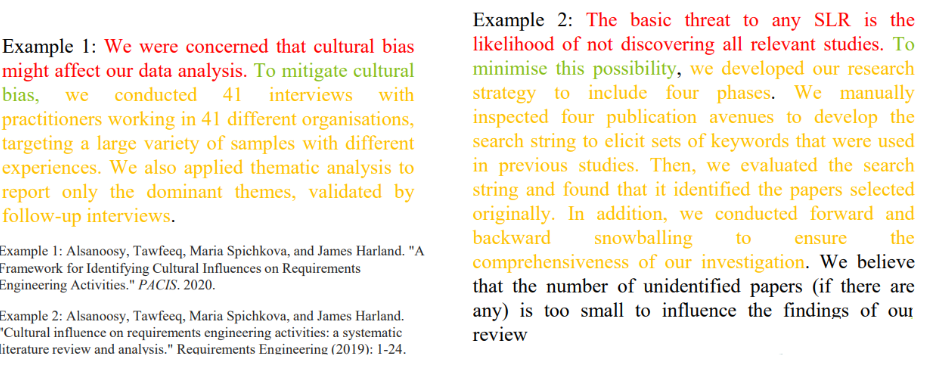
The conclusion (see the dedicated course for more details)
The conclusion is generally short.
It summarizes what you did (note! This is not a summary).
It recalls the significant contribution and discoveries.
The reader can read the title, quickly see the summary, the structure of the article, then the introduction and conclusion. So give the key information in the conclusion.
You can add other works, but avoid developing new ideas.
Do not introduce new arguments. Do not plagiarize your results and discussion.
Make transitions!
Transitions are essential to facilitate the reading of a scientific paper (called scientific paper transition).
Clear transitions are crucial for clear writing: they show the reader how the different parts of your essay, article or thesis relate together. Transition sentences can be used to structure your text and connect paragraphs or sections.
Transitions between paragraphs
When you start a new paragraph, the first sentence should clearly state:
- What this paragraph will discuss
- How does this relate to the previous paragraph
The examples below show some examples of transition sentences between paragraphs and what they express.
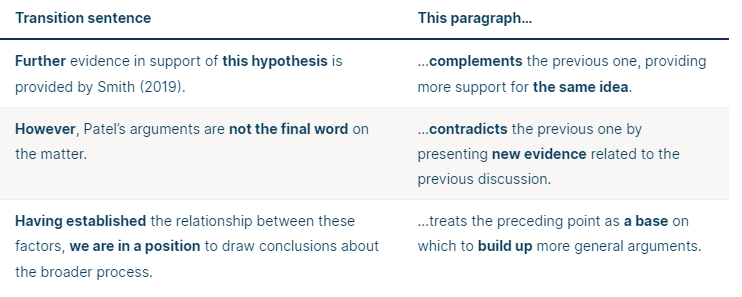
The beginning of a new paragraph is usually the right place for a transition sentence. Each paragraph should focus on one topic, so avoid spending time at the end of one paragraph explaining the theme of the next.

Transitions between sections
While transitions between paragraphs are usually a single sentence, when starting a new section in longer text, you may need an entire transition paragraph. Transitioning to a new section involves summarizing the content of the previous section and expressing how the new one will build on or deviate from it.
For example, the following sentences could be an effective transition for a new section in a literary analysis essay.

In blue, the text refers to the conclusion of the previous section. In green, the text announces the content of this new section. In purple, the text announces the objective of the new section.
Sometimes it is important to announce the plan of the new section in a roundabout way, such as by presenting the different points that will be covered.
The transition, which therefore acts as an introduction to the new section, must respond to the conclusion of the previous section(s).
For greater clarity, it is possible to put the transition after the Section Title, that is to say before starting the first subsection.
Transitions in a paragraph (to better break up the thesis of a paragraph)
It is also important to use effective transitions in each paragraph you write, guiding the reader through your arguments effectively and avoiding ambiguity.
The order of information in each of your sentences is important for the cohesion of your text. The New Known Contract, a useful writing concept, states that a new sentence should generally begin with a reference to information in the previous sentence and then continue by connecting it to new information.
In the following example, the second sentence does not follow very clearly from the first. The connection only becomes clear when we reach the end. By reordering the information in the second sentence so that it begins with a reference to the first, we can help the reader follow our argument more easily.
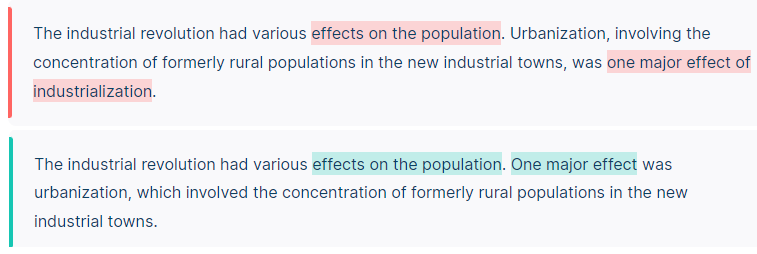
Using appropriate transition words helps show your reader's connections within and between sentences. Transitional words and expressions come in four main types:
- Additive transitions, which introduce new information or examples
- Adversative transitions, which signal a contrast or deviation from the preceding text
- Causal transitions, which are used to describe cause and effect
- Sequential transitions, which indicate a sequence
The table below gives some examples for each type:
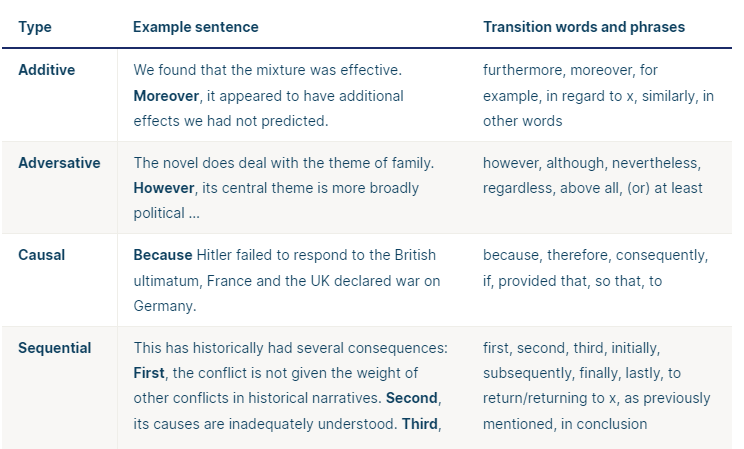
Although transitional words and phrases are essential and every essay contains at least some of them, it is also important to avoid overusing them. One way to do this is to group similar information together to reduce the number of transitions needed.
For example, the following text uses three transition words and jumps from one idea to another. This makes it repetitive and difficult to follow. Rewriting it to group similar information allows us to use a single transition, making the text more concise and readable.
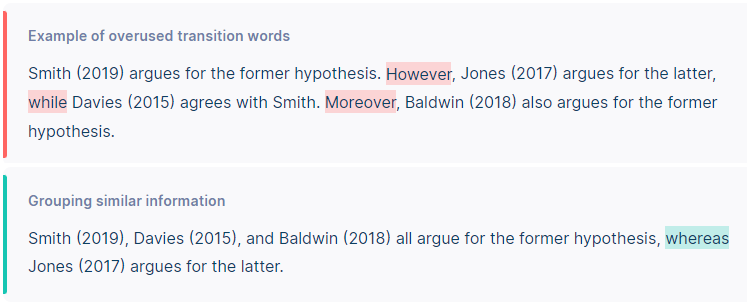
Write paragraph content well
In scientific papers, the basic elements of any intellectual or research argument are paragraphs. Each paragraph should be a single unit of thought, a discrete set of ideas composed of closely related sentences.
The most generally applicable sequence to follow is — Topic, Body, Tokens, Wrap.
The opening "topic" sentence alerts readers to a change in topic and focus, and tells readers (in "signpost" mode) what the paragraph covers. It should never be linked backwards to material that preceded it (links are always made forwards in "wraparound" sentences).
So be wary of starting with linking words (such as "However", "Nevertheless", "Furthermore"), lest they lead you to look back. Instead, topic sentences should clearly signal a new focus of attention.
Yet they must also be written carefully, to give readers the impression of a smooth, “natural” progression of thought. Also remember that a sign is nothing more than a brief spotting or naming prompt, not a mini-tour guide or preview of the argument to come.
The main “body” sentences provide the central argument. In research work, they must clearly and carefully present their reasoning, describe results, develop implications, elucidate formulas or develop and explain theoretical and thematic points. The body sentences constitute the dominant current of the paragraph, the core of the unit of thought.
Researchers must normally offer tokens to back up and support their basic arguments. “Symbolic” sentences can be sprinkled across a paragraph among the body sentences, at appropriate points where they are most necessary or useful.
Typically, token phrases are examples, references, quotations from other authors, supporting facts or analysis of "points of attention", exhibits, tables, graphs or diagrams that accompany them. To some extent, “symbolic” sentences are inherently digressive: they potentially move away from the mainstream of the paragraph.
Therefore, they need careful management, especially when two or more token phrases follow one another, without intervening "body" phrases.
Finally, the phrase “wrap” serves to bring the argument together, to make readers understand that a building block has been put in place. It should be constructive and substantive, adding value to the argument, and not simply repeating early material. It should also handle any link to the next paragraph that is necessary.
Rational, skimming readers do not treat all parties the same. Seeking the quickest possible appreciation of what is being said, they pay particular attention to the beginning and end of paragraphs, the subject and accompanying sentences — a technique commonly taught in “reading” classes. fast ".
When and if they look more closely inside the body of the paragraph, readers may also initially skip over symbolic phrases. And they will normally delay digging into "hard" formulas or difficult expository materials in search of a more intuitive (if rough) understanding gleaned from the sentences that precede or follow them.
It follows that the beginning and end of paragraphs must always be written with the greatest care. Try separating these two sentences and looking at them together. Check how they read, how substantive and informative they are, and how they could be improved.
Structuring paragraph content
Six things most often go wrong when writing paragraphs:
1. The author starts with a link to the previous paragraph, instead of a new topic sentence. Readers may conclude that it is just “more of the same” and move on to the next paragraph. Even those who persist can become confused — what are we going to talk about?
2. The paragraph begins with a formality sentence or other form of insubstantial sentence (or perhaps several such sentences). For example, authors may begin by discussing a caveat, definition, difficulty, or methods problem that is part of the provenance of the argument to be presented.
If they persevere in their reading, they may fail to correctly identify the now submerged topic sentence and then find that the wrapping sentence seems unwarranted or tendentious because it does not fit the apparent topic.
3. The author begins with the name and reference of another author, for example: “Harding (2007: 593) argues…” supports the work of others. Some students tend to write in this manner, extending over several pages, each beginning with the name of another author, particularly in the "literature review" sections.
But when the first words are someone else's name, the writer inadvertently signals: "Here's a completely derived paragraph" — "or a section if this pattern repeats." The common reaction of critical readers is therefore to downgrade or skip the paragraph (or the entire section) and move on.
The easy solution to this problem begins by not thinking in terms of individual authors, but instead focusing on the schools of thought, or "sides" in an empirical controversy, that the authors to be cited represent. Write a clear, self-contained topic sentence.
Then explain the basic ideas or propositions of one or more schools of thought involved in the body sentences. Relegate author names to supporting references that come at the end of sentences, where they belong.
4. A paragraph stops abruptly, usually because the writer realized it was too long. This usually happens because symbolic phrases have multiplied—perhaps because the intended brief exposition of an example or analysis of an exhibit has become unwieldy.
Usually, writers here do a forced "emergency stop", then usually write what should have been the final sentence at the start of the next one. The first then has a sequence of Subject, Body, Tokens but no looping sentence. And the next paragraph 2 starts with the moved wrap1 phrase, and has a buried topic2 phrase (like that course you're reading, but hey SEO doesn't like big blocks!).
5. Paragraphs become too long, extending beyond the acceptable search text range of 100 to 200 words to occupy 300 words or more. This often happens because the tokens have multiplied or swelled beyond the limits that can be easily manipulated.
But due to their partly digressive character, the author hesitates to recognize the need to separate the tokens to treat them thematically. Especially when discussing points of attention or exposition that are complex and not designed to be self-contained and easy to understand, body and symbolic sentences can become confused, creating a text where the main argument becomes difficult to distinguish.
The solution must be brutal. Once a paragraph exceeds 250 words, it should be partitioned, usually as evenly as possible, and separate topic and cover sentences provided for each part.
If the problem arises from overly long exposure of a token or exposition, then the author must find a solution that can smoothly handle a partial digression. If a paragraph is between 200 and 250 words, this can be kept, as long as the looping sentence can still reconnect readers to the (now rather distant) topic sentence.
6. A paragraph is too short. For a search text, this happens if it is less than 100 words, and especially if it consists of a single sentence or less than 50 words. Short paragraphs occur because an author does not know what to say, or has not properly thought through how a point or set of points fit together or can be sequenced within the overall argument. Some reflect mixtures of points that the author did not recognize as such.
Other single-sentence paragraphs are "orphan" sentences that should be embedded in nearby longer paragraphs but have not been—for example, in seed lists or sequences of connected paragraphs. Orphan sentences must always be merged with their neighbors, so that they disappear.
Two groups of people need to be especially careful to adapt to this paragraph convention at the research level. First, Latin languages often write using several very short or single-sentence paragraphs, organized in subtle thematic ways that English-speaking readers have difficulty following (so don't do like this course :)
Such an audience will often only see a disconcerting multiplicity of orphans interpreted as disorganized thinking. Second, journalists, and now some academic bloggers as well, use short paragraphs that look good on newsprint or in narrow or spaced blog columns (that's what I'm saying, like this course!).
All these types of authors need to aggregate orphans into longer ones of at least 100-200 words if they want to publish journal articles or research books in English. If you've ever seen a journalist's writing transposed into book form without this change, you'll appreciate that there are also strong aesthetic reasons for making this change.
Manage citations
Managing citations for a scientific paper or article is very important to prove that you know your research framework and your niche.
Citing your sources correctly is also important for many reasons. One of the most important is that you can easily establish for your reviewers and readers the context and relevance of your work.
The main reason to cite references correctly is to avoid intellectual dishonesty. Presenting other researchers' ideas without proper acknowledgment goes against scientific ethics. While this is not the highest ethical standard, it is simply basic decency.
This is because we humans have a strong sense of ownership, not only of our physical properties, but also of our intellectual works and achievements. We have a strong desire to know who or where exactly information comes from and how ideas develop.
You must properly reference a source even if you have reformulated the idea you got from it. Properly referencing a source is not only important for the right people to get proper recognition for their ideas. It is also crucial to the entire process of publishing and consuming research for the following reasons:
- To avoid plagiarism – Citations allow researchers to properly cite the work of others. This helps them recognize where information is coming from.
- Respect for intellectual property rights – Research work may include industry information legally protected by intellectual property rights. These include trademarks, patents, industrial designs and geographical indications. Creative works for entertainment are also included, ranging from films to architectural designs.
- To provide evidence – Citing studies and data correctly allows you to provide evidence for key points in your work. This is especially important when advocating for a position you take.
- To give details of the source documents – Citations make it easier for reviewers to verify the data and even the line of argument. Additionally, it helps direct readers to original sources where they can find more detailed information about the point you cited and the topic.
Overall, referencing helps research communities place a work in context to better judge its potential impact on its field.
There are many different fields and disciplines in the world of research. And, they have different styles and standards for what proper SEO is. The rules also vary depending on the types of sources you cite, including but not limited to research papers, technical reports, books, patents, court cases, conference journals, conference, podcasts, YouTube videos and social media posts.
For the majority of scientific articles, you can use LaTeX to manage your citations, I invite you to consult the LaTeX course to find out more.
Like most things, citing a source should be done in reasonable amounts. You should avoid underquoting and overquoting. The first is when you fail to cite a source while the second is when you put unnecessary citations that may be too distracting. By citing all sources used and giving proper credit to the actual authors, academic writers not only prevent plagiarism, but also show that they have conducted thorough research, are knowledgeable about the subject of the study, and that their research is reliable.
The components of a citation or reference are designed to allow the reader to identify or locate the specific source that is being cited (Lanning, 2016). Any time you use another individual's work, you really need to cite a source. Forgetting or intentionally not doing so can seriously damage your reputation. So, remember to cite properly when you:
- Cite the exact words of the authors
- Paraphrase or state the ideas of others in your own words
- Refer to data or datasets
- Reprint a long passage of text or copyrighted test item
- Reprint or adopt any figure or table, including free images and diagrams from the Internet, even when free or licensed through Creative Commons
When authors fail to cite their sources, they commit undercitation, as the APA calls it (nd). This leads to plagiarism. This is really frowned upon, not just in the academic research community. It's also a no-no in all types of posts, from movies to music. It is therefore preferable to be very careful in collecting and referencing your sources. But you also have to be careful not to be too detailed. Too much care or fear of underquoting can lead to overdoing it.
Putting more citations than necessary is called overquoting. It is also frowned upon but to a lesser extent. The reasoning here is that when you place inappropriate amounts of quotes, it can be quite distracting for readers. This is especially true when it comes to in-text citations. Readers and reviewers will have difficulty following the thoughts and arguments in your paper if they are constantly interrupted by unnecessary in-text citations. This can really get annoying.
Overquoting usually occurs when authors repeat the same quote in every sentence, even though the subject and source have not changed at all. To avoid overdoing citations when paraphrasing, remember to place a citation for a key point in a paragraph only in the first sentence where it is relevant. Do not repeat the quote when the source of the material remains clear and the same.
Additionally, overquoting can also be very unethical, especially when a writer cites a source as evidence, even if the source doesn't really count as one. This unethical practice usually occurs when an author cites a study or data set to support a claim, but when reviewers and readers go through the source, they will find that it is not valid evidence of the author's assertion.
Sometimes this can happen unintentionally, particularly when an author misunderstands what has been cited or the implications of the information cited. But, there may be cases where there is malicious intent to increase the credits of a claim by strengthening the cited works. This must be avoided at all costs.
Additionally, writers are strongly discouraged from quoting themselves, especially when their works are unrelated. It can be quite tempting to cite your work or that of your colleagues to boost your profiles or publications. But, this should be avoided to keep the integrity of the work in progress. Reviewers and other researchers are able to recognize self-promotion when they see it. Stay in the context of work and avoid unrelated things and self-promotion.
How to make citations?
In-text citations let users know which ideas are attributed to whom. Citation style has two major elements for in-text citation: the author and the date or sometimes just a number. It is possible to refer to it either by direct quote (in parentheses or brackets) or by mention in a narrative arc (with the quote as a bonus).
Parenthetical citations
A parenthetical citation may appear inside or at the end of a sentence.
…98 % of the participants (Smith, 2014).
…regardless of the age of the discoveries (see Bishop, 1996, for more explanations).
…(e.g. experimental anomalies in clinical trials; Chan, 2015).
Narrative Quotes
In narrative quotations, the author's last name appears in the running text while the quotation follows it directly.
Yang [1] suggested that…
In 2004, Yang [1] concluded that…
Rules for multiple authors
- For a single author
Coleman (2019) stated that…
…hominids hunted big game (Coleman, 2019).
- For two authors
Smith and Johnson (2020) avoided the term…
… paradigm because of its use in ordinary language (Smith & Johnson, 2020).
- For three or more, use the first author's last name and "et al." » even for the first quote:
…especially when observers are involved (James et al., 2017).
…for complex adaptive systems (Chambers et al., 2019).
Chambers et al. [1] propose a model…